A Study on the Retrieval of Ozone Profiles Using FY-3D/HIRAS Infrared Hyperspectral Data
Abstract
1. Introduction
2. Instruments and Data
2.1. Instrument Introduction
2.2. Experiment Area and Time
2.3. GFS Forecast Data
2.4. ERA5 Reanalysis Data
2.5. AIRS Data
2.6. WOUDC Site Data
2.7. OMPS Data
3. Ozone Retrieval Experimental Process
3.1. Data Pre-Processing
3.1.1. Spectral Data Apodization
3.1.2. Selection of Clear Sky Pixels
3.2. RTTOV Model
3.3. Observation Error Correction
3.4. Observation and Background Errors
3.4.1. Observation Error Covariance Matrix
3.4.2. Background Error Covariance Matrix
3.5. Channel Selection and ER (Entropy Reduction) and DFS (Degrees of Freedom for Signal) Calculation
3.5.1. Channel Selection
3.5.2. ER and DFS Calculation
3.6. Neural Network Algorithm
3.7. One-Dimensional Variational Retrieval Algorithm
3.7.1. Building the Objective Function
3.7.2. The Solution—The Newton Iteration
3.8. Setting up the Experimental System
3.9. Conversion Formula Unit Unity and Error Evaluation and Analysis Method
3.9.1. MMR and VMR Conversion Formulas
3.9.2. Number Density to Volume Mixing Ratio VMR
3.9.3. Error Evaluation and Analysis Method
4. Experimental Results
4.1. Experimental Results
Ozone Concentration Profile Obtained from Retrieval
4.2. Verification and Discussion of Experimental Results
4.2.1. Comparison and Discussion of Two Initial Profiles and Retrieval Results
4.2.2. Comparison and Analysis of Retrieval Results with OMPS Data
4.2.3. Comparison and Analysis of AIRS Products and Retrieval Results
4.3. Effects of Temperature and Water Vapor on Ozone Retrieval
5. Discussion
6. Conclusions
Author Contributions
Funding
Data Availability Statement
Acknowledgments
Conflicts of Interest
References
- Wang, G.Q. Study of Atmosphere Ozone; Beijing Science Press: Beijing, China, 1985. [Google Scholar]
- Pan, L.; Niu, S.-J. A Comparison of Total Column Ozone Values Derived from AIRS, TOVS and TOMS. Remote Sens. 2008, 12, 54–63. [Google Scholar]
- Yao, Q.; Han, S.Q.; Cai, Z.Y.; Wang, J. The diurnal variation and ozone production potential of BTEX in Tianjin in the summer of 2012. China Environ. Sci. 2013, 33, 793–798. [Google Scholar]
- Yi, R.; Wang, Y.L.; Zhang, Y.J.; Shi, Y.; Li, M.S. Pollution characteristics and influence factors of ozone in Yangtze River Delta. Acta Sci. Circumstantiae 2015, 35, 2370–2377. [Google Scholar]
- Li, H.; Li, L.; Huang, C.; An, J.Y.; Yan, R.S.; Huang, H.Y.; Chen, M.H. Ozone source apportionment at urban area during a typical photochemical pollution episode in the summer of 2013 in the Yangtze River Delta. Environ. Sci. 2015, 36, 1–10. [Google Scholar]
- Zhong, L.J.; Louie, P.K.K.; Zheng, J.Y.; Yuan, Z.; Yue, D.; Ho, J.W.; Lau, A.K. Science-policy interplay: Air quality management in the Pearl River Delta region and Hong Kong. Atmos. Environ. 2013, 76, 3–10. [Google Scholar] [CrossRef]
- Zhan, S. Research on Changing Trend and Influencing Factors of Conventional Air Pollutants in Guangdong-Hong Kong-Macao Greater Bay Area; The University of Chinese Academy of Sciences (Guangzhou Institute of Geochemistry, Chinese Academy of Sciences): Beijing, China, 2018. [Google Scholar]
- Dong, C.-H.; Li, J.; Zhang, P. The Principle and Application of Satellite Hyperspectral Infrared Atmospheric Remote Sensing; Science Press: Beijing, China, 2013. (In Chinese) [Google Scholar]
- Boisvert, L.N.; Wu, D.L.; Vihma, T.; Susskind, J. Verification of air/surface humidity differences from AIRS and ERA-Interim in support of turbulent flux estimation in the Arctic. J. Geophys. Res. Atmos. 2015, 120, 945–963. [Google Scholar] [CrossRef]
- Boisvert, L.N.; Petty, A.A.; Stroeve, J.C. The impact of the extreme winter 2015/16 Arctic cyclone on the Barents-Kara Seas. Mon. Weather Rev. 2016, 144, 4279–4287. [Google Scholar] [CrossRef]
- Wang, Y.; Guan, L. Quality assessment of FY-4A’s geostationary interferometric infrared sounder observations data. Infrared Laser Eng. 2022, 51, 178–189. [Google Scholar]
- Keim, C.; Eremenko, M.; Orphal, J.; Dufour, G.; Flaud, J.-M.; Höpfner, M.; Boynard, A.; Clerbaux, C.; Payan, S.; Coheur, P.-F.; et al. Tropospheric ozone from IASI: Comparison of different inversion algorithms and validation with ozone sondes in the northern middle latitudes. Atmos. Chem. Phys. 2009, 9, 9329–9347. [Google Scholar] [CrossRef]
- Qi, C.-L.; Gu, M.-J.; Hu, X.-Q.; Wu, C. FY-3 Satellite infrared high spectral sounding technique and potential application. Adv. Met ST 2016, 6, 88–93. [Google Scholar]
- Pan, L. Ozone Profile Retrieval and Aerosol Classification Based on the Satellite Measurement; Nanjing University of Information Science and Technology: Nanjing, China, 2007. [Google Scholar]
- Liou, K.N. An Introduction to Atmospheric Radiation; China Meteorogical Press: Beijing, China, 2004. [Google Scholar]
- Ma, P.-F.; Chen, L.-F.; Zou, M.-M.; Zhang, Y.; Tao, M.-H.; Wang, Z.-F.; Su, L. Analysis of the Influence of Temperature on the Retrieval of Ozone Vertical Profiles Using the Thermal Infrared CrIS Sounder. Spectrosc. Spectr. Anal. 2015, 35, 3344–3349. [Google Scholar]
- Zhang, L.; Ding, M.H.; Bian, L.G.; Li, J. Validation of AIRS temperature and ozone profiles over Antarctica. Chin. J. Geophys. 2020, 63, 1318–1331. (In Chinese) [Google Scholar]
- Luo, Q. Ozone Profile Retrieval and Validation Research for Atmospheric Infrared Ultraspectral Spectrometer onboardGaoFen-5; University of Chinese Academy of Sciences: Beijing, China, 2020. [Google Scholar]
- Wang, Y. Research on Temperature/Pressure and Ozone Retrieval Algorithm Based on Atmospheric Infrared Ultraspectral Spectrometer; University of Chinese Academy of Sciences: Beijing, China, 2017. [Google Scholar]
- Cai, X.; Bao, Y.-S.; Petropoulos, G.P.; Lu, F.; Lu, Q.; Zhu, L.; Wu, Y. Temperature and Humidity Profile Retrieval from FY4-GIIRS Hyperspectral Data Using Artificial Neural Networks. Remote Sens. 2020, 12, 1872. [Google Scholar] [CrossRef]
- Zhang, C.; Gu, M.; Hu, Y.; Huang, P.; Yang, T.; Huang, S.; Shao, C. A Study on the Retrieval of Temperature and Humidity Profiles Based on FY-3D/HIRAS Infrared Hyperspectral Data. Remote Sens. 2021, 13, 2157. [Google Scholar] [CrossRef]
- Huang, P.-Y.; Guo, Q.; Han, C.-P.; Zhang, C.; Yang, T.; Huang, S. An Improved Method Combining ANN and 1D-Var for the Retrieval of Atmospheric Temperature Profiles from FY-4A/GIIRS Hyperspectral Data. Remote Sens. 2021, 13, 481. [Google Scholar] [CrossRef]
- Yang, T.-H. Tropospheric Wind Field Measurement Based on Infrared Hyperspectral Observations; University of Chinese Academy of Sciences: Beijing, China, 2020. [Google Scholar]
- Qi, C.L.; Zhou, F.; Wu, C.Q.; Hu, X.Q.; Gu, M.J. Spectral Calibration of Fengyun-3 high-spectral resolution infrared sounder. Opt. Precis. Eng. 2019, 27, 747–755. [Google Scholar]
- Zhao, Y. Principles and Methods of Remote Sensing Application Analysis; Science Press: Beijing, China, 2003. [Google Scholar]
- Ren, J. Study on the Atmospheric Temperature and Humidity Profiles of Satellite Remote Sensing Based on One-Dimensional Variational Algorithm. Master’s Thesis, Nanjing University of Information Science and Technology, Nanjing, China, 2018. [Google Scholar]
- Guan, Y.H.; Ren, J.; Bao, Y.S.; Lu, Q.; Liu, H.; Xiao, X. Research of the infrared high spectral (IASI) satellite remote sensing atmospheric temperature and humidity profiles based on the one-dimensional variational algorithm. Trans. Atmos. Sci. 2019, 42, 602–611. [Google Scholar]
- Saunders, R.; Matricardi, M.; Brunel, P. An improved fast radiative transfer model for assimilation of satellite radiance observations. Q. J. R. Meteorol. Soc. 1999, 125, 1407–1425. [Google Scholar] [CrossRef]
- Di, D.; Li, J.; Han, W.; Bai, W.; Wu, C.; Menzel, W.P. Enhancing the fast radiative transfer model for FengYun-4 GIIRS by using local training profiles. J. Geophys. Res. Atmos. 2018, 123, 12583–12596. [Google Scholar] [CrossRef]
- Bai, W.-G.; Zhang, P.; Zhang, W.-J.; Li, J. An efficient method for hyper-spectral infrared atmospheric radiation transfer calculation. J. Infrared Millim. Waves 2016, 35, 99–108. [Google Scholar]
- Zhu, L.H.; Bao, Y.S.; Petropoulos, G.P.; Zhang, P.; Lu, F.; Lu, Q.F.; Wu, Y.; Xu, D. Temperature and Humidity Profiles Retrieval in a Plain Area from Fengyun-3D/HIRAS Sensor Using a 1D-VAR Assimilation Scheme. J. Remote Sens. 2020, 12, 435. [Google Scholar] [CrossRef]
- Hewison, T.J. 1D-VAR retrieval of temperature and humidity profiles from a ground-based microwave radiometer. IEEE Trans. Geosci. Remote Sens. 2007, 45, 2163–2168. [Google Scholar] [CrossRef]
- Crevoisier, C. AIRS channel selection for CO2 and other trace-gas retrievals. Meteorol. Soc. 2003, 129, 2719–2740. [Google Scholar] [CrossRef]
- Menke, W. Geophysical Data Analysis: Discrete Inverse Theory; Academic Press: New York, NY, USA, 1984. [Google Scholar]
- Luo, S.; Di, D.; Cui, L.-L. Study on FY-4A/GIIRS infrared spectrum detection capability based on information content. J. Infrared Millim. Waves 2019, 38, 765–776. [Google Scholar]
- Rodgers, C.D. Information content and optimisation of high spectral resolution remote measurements. Adv. Space Res. 1996, 21, 136–147. [Google Scholar] [CrossRef]
- Pengyu, H.; Qiang, G.; Changpei, H.; Huangwei, T.; Chunming, Z.; Tianhang, Y.; Shuo, H. An Improved Method Combining CNN and 1D-Var for the Retrieval of Atmospheric Humidity Profiles from FY-4A/GIIRS Hyperspectral Data. Remote Sens. 2021, 13, 4737. [Google Scholar]
- Zhang, C.; Qi, C.; Yang, T.; Gu, M.; Zhang, P.; Lee, L.; Hu, X. Evaluation of FY-3E/HIRAS-II Radiometric Calibration Accuracy Based on OMB Analysis. Remote Sens. 2022, 14, 3222. [Google Scholar] [CrossRef]
- Boukabara, S.-A.; Garrett, K.; Chen, W.; Iturbide-Sanchez, F.; Grassotti, C.; Kongoli, C.; Chen, R.; Liu, Q.; Yan, B.; Weng, F.; et al. MiRS: An All-Weather 1DVAR Satellite Data Assimilation and Retrieval System. IEEE Trans. Geosci. Remote Sens. 2011, 49, 3249–3272. [Google Scholar] [CrossRef]
- Yang, J.; Min, Q. Retrieval of Atmospheric Profiles in the New York State Mesonet Using One-Dimensional Variational Algorithm. J. Geophys. Res. Atmos. 2018, 123, 7563–7575. [Google Scholar] [CrossRef]
- Jang, H.S.; Sohn, B.J.; Chun, H.W.; Li, J.; Weisz, E. Improved AIRS temperature and moisture soundings with local a priori information for the 1DVAR method. J. Atmos. Ocean. Technol. 2017, 34, 1083–1095. [Google Scholar] [CrossRef]
- Duncan, D.I.; Kummerow, C.D. A 1DVAR retrieval applied to GMI: Algorithm description, validation, and sensitivities. J. Geophys. Res. Atmos. 2016, 121, 7415–7429. [Google Scholar] [CrossRef]
- Martinet, P.; Dabas, A.; Donier, J.M.; Douffet, T.; Guillot, O.G.R. 1D-Var temperature retrievals from microwave radiometer and convective scale model. Tellus A Dyn. Meteorol. Oceanogr. 2015, 67, 27925. [Google Scholar] [CrossRef]
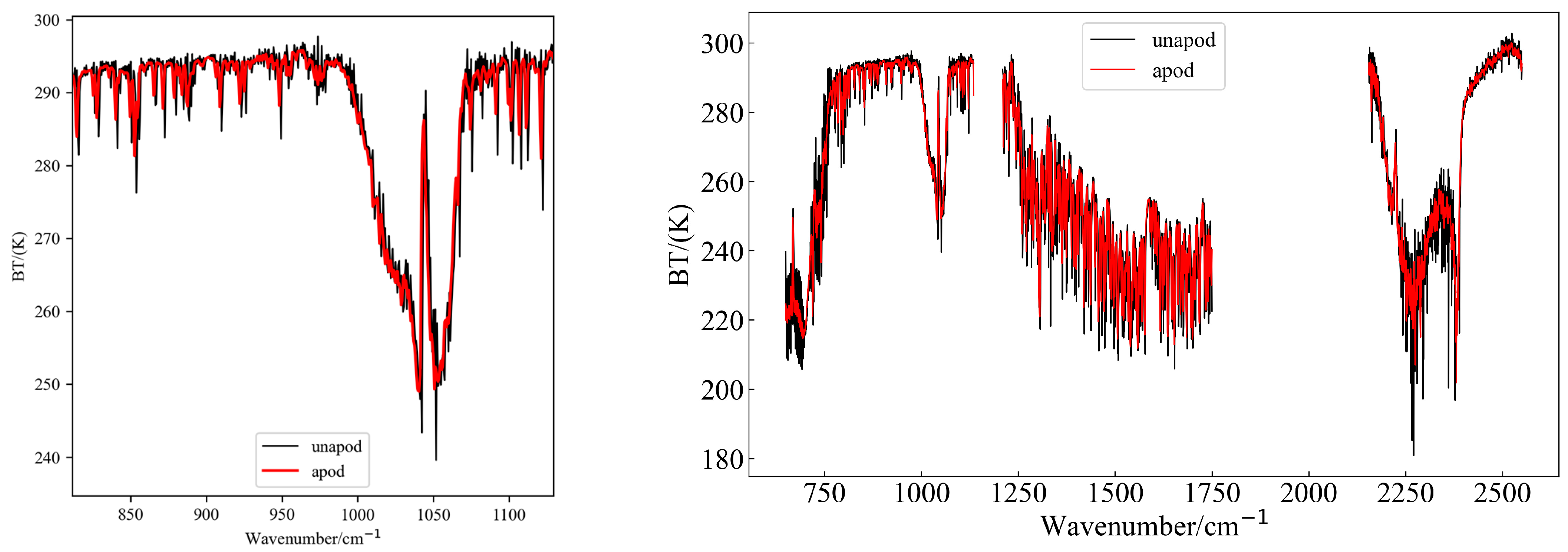
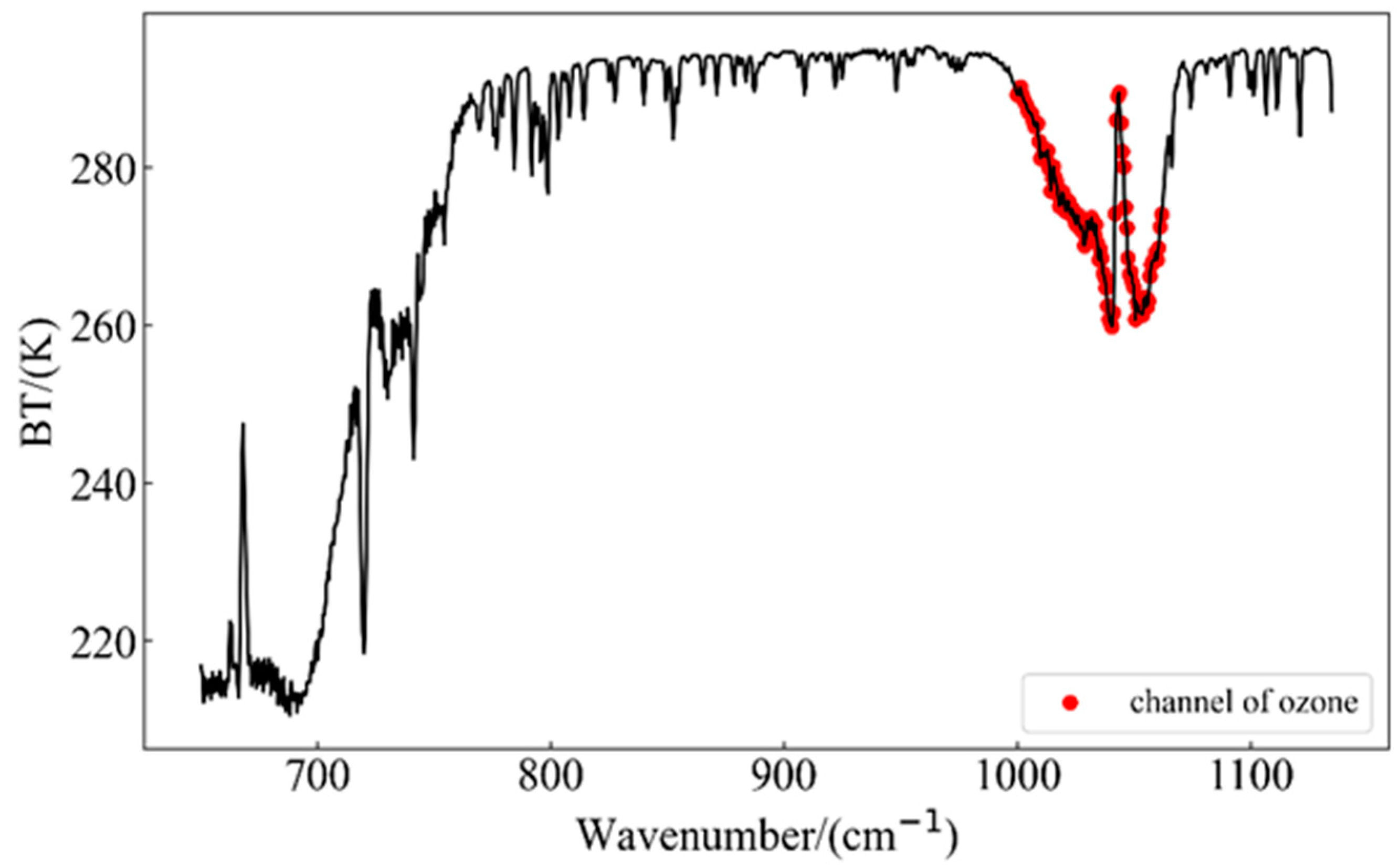


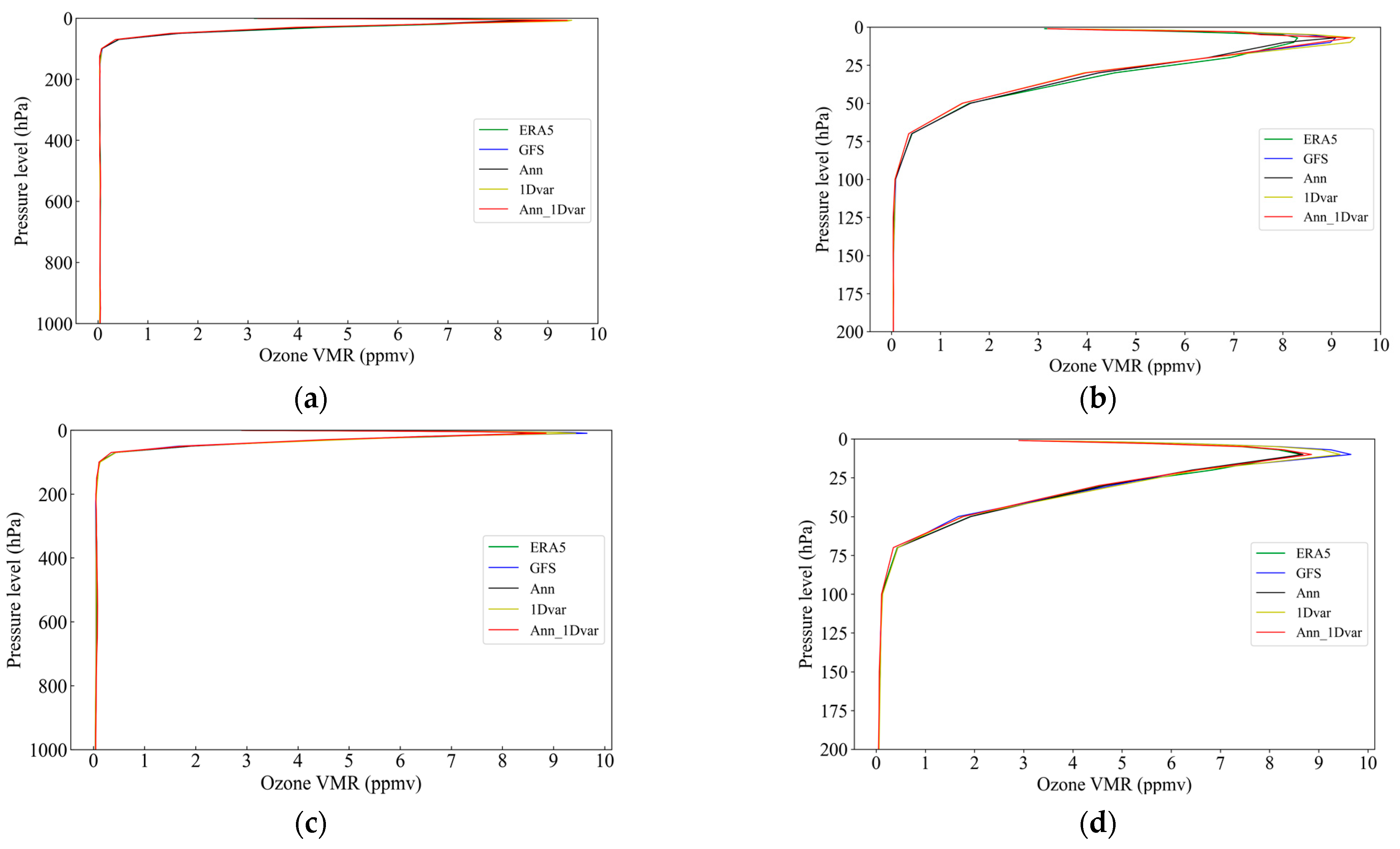
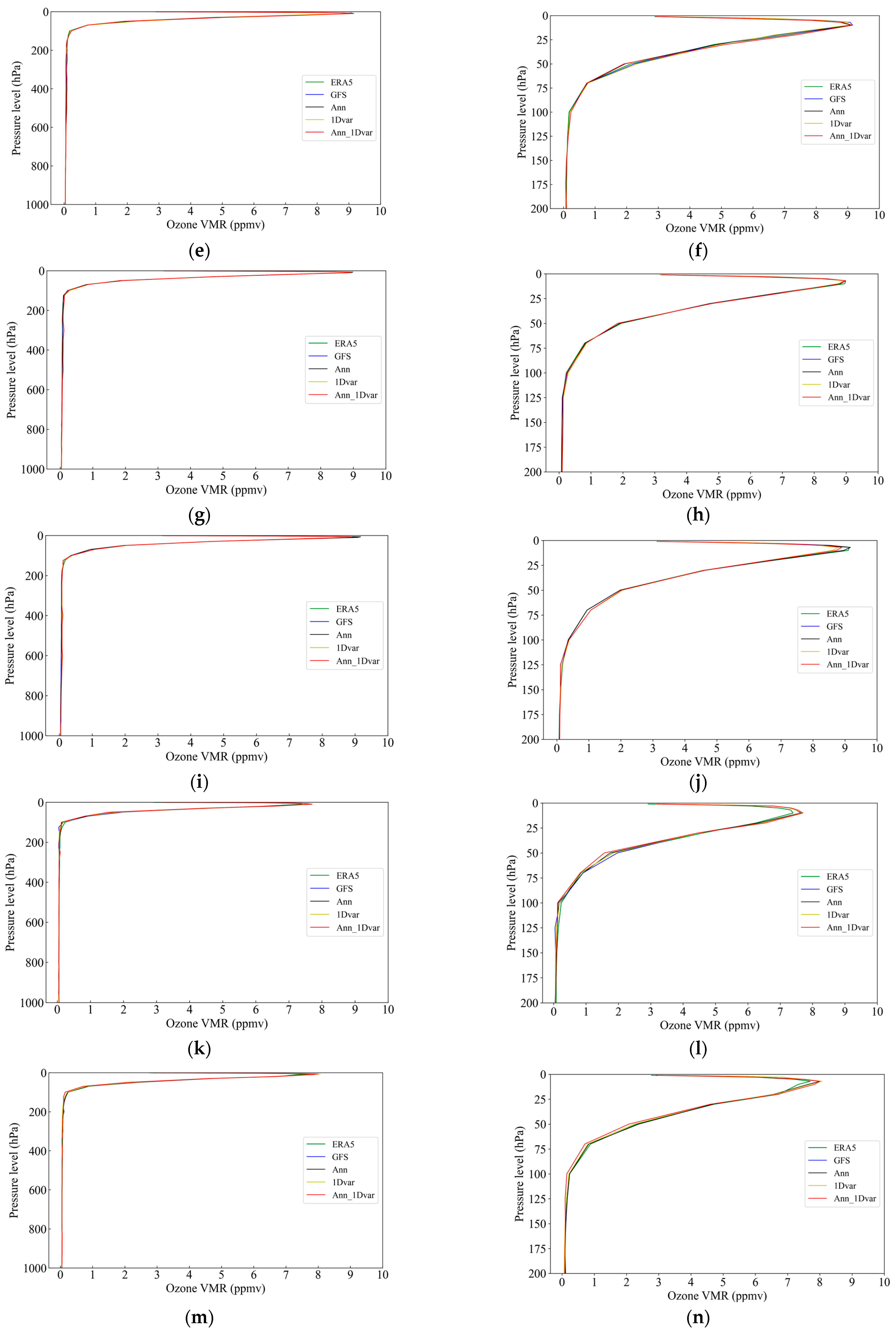







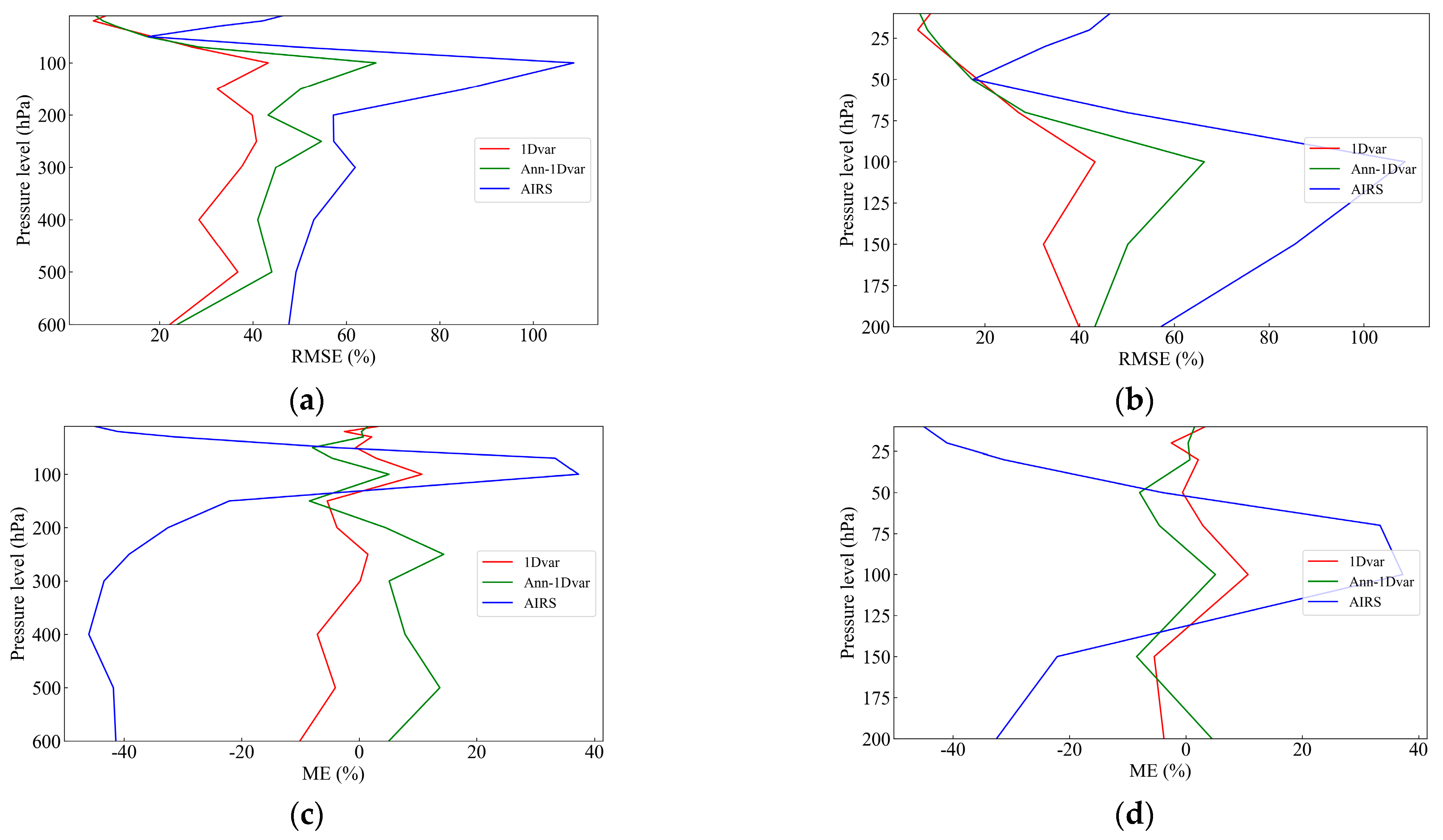



| Wavenumber (cm−1) | Spectral Resolution (cm−1) | Number of Channels | |
|---|---|---|---|
| Spectral Characteristics | Long-Wave: 648.75–1134 | 0.625 | 781 |
| Medium-Wave: 1208.5–1749.375 | 0.625 | 869 | |
| Short-Wave: 2153.75–2549.375 | 0.625 | 637 | |
| Performance index | Scan cycle | 10 s | |
| Field of view | 1.1° | ||
| Maximum scanning angle | ±50.4° | ||
| Radiometric calibration accuracy | 0.7 K | ||
| Spectral calibration accuracy | 7 ppm | ||
| Experimental Time | DFS | ER |
|---|---|---|
| 2021_0113_0550 | 1.05 | 2.53 |
| 2021_0224_0555 | 1.02 | 2.61 |
| 2021_0526_0530 | 1.14 | 3.24 |
| 2021_0728_0535 | 1.12 | 3.05 |
| 2021_0818_0535 | 1.11 | 3.19 |
| 2021_1110_0540 | 1.03 | 2.94 |
| 2021_1114_0605 | 1.04 | 3.09 |
| Barosphere | Ann_1Dvar Retrieval Method | 1Dvar Retrieval Method |
|---|---|---|
| the upper stratosphere (1–25 hPa) | √ | |
| the middle and lower stratosphere (25–100 hPa) | √ | |
| the upper troposphere (100–300 hPa) | √ | |
| the middle and lower troposphere (300–800 hPa) | √ | |
| the near surface (800–1000 hPa) | √ |
Disclaimer/Publisher’s Note: The statements, opinions and data contained in all publications are solely those of the individual author(s) and contributor(s) and not of MDPI and/or the editor(s). MDPI and/or the editor(s) disclaim responsibility for any injury to people or property resulting from any ideas, methods, instructions or products referred to in the content. |
© 2023 by the authors. Licensee MDPI, Basel, Switzerland. This article is an open access article distributed under the terms and conditions of the Creative Commons Attribution (CC BY) license (https://creativecommons.org/licenses/by/4.0/).
Share and Cite
Xie, M.; Gu, M.; Hu, Y.; Huang, P.; Zhang, C.; Yang, T.; Yang, C. A Study on the Retrieval of Ozone Profiles Using FY-3D/HIRAS Infrared Hyperspectral Data. Remote Sens. 2023, 15, 1009. https://doi.org/10.3390/rs15041009
Xie M, Gu M, Hu Y, Huang P, Zhang C, Yang T, Yang C. A Study on the Retrieval of Ozone Profiles Using FY-3D/HIRAS Infrared Hyperspectral Data. Remote Sensing. 2023; 15(4):1009. https://doi.org/10.3390/rs15041009
Chicago/Turabian StyleXie, Mengzhen, Mingjian Gu, Yong Hu, Pengyu Huang, Chunming Zhang, Tianhang Yang, and Chunlei Yang. 2023. "A Study on the Retrieval of Ozone Profiles Using FY-3D/HIRAS Infrared Hyperspectral Data" Remote Sensing 15, no. 4: 1009. https://doi.org/10.3390/rs15041009
APA StyleXie, M., Gu, M., Hu, Y., Huang, P., Zhang, C., Yang, T., & Yang, C. (2023). A Study on the Retrieval of Ozone Profiles Using FY-3D/HIRAS Infrared Hyperspectral Data. Remote Sensing, 15(4), 1009. https://doi.org/10.3390/rs15041009









